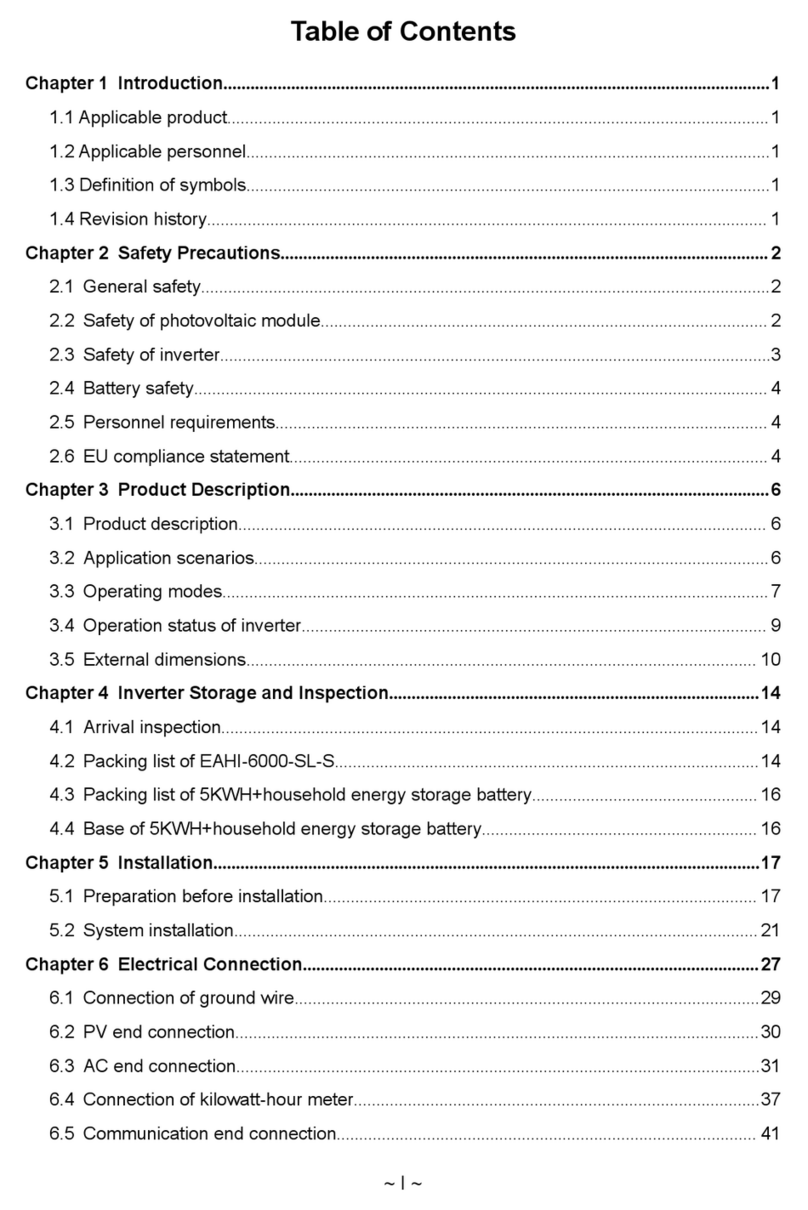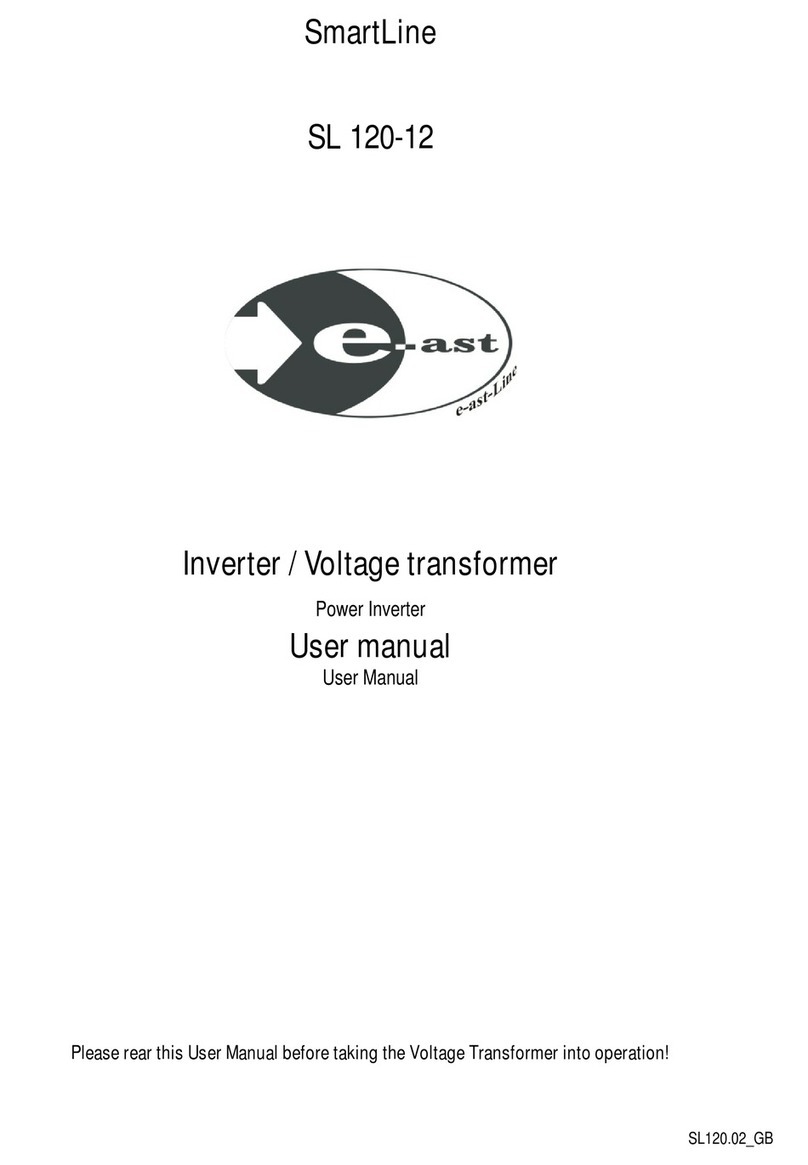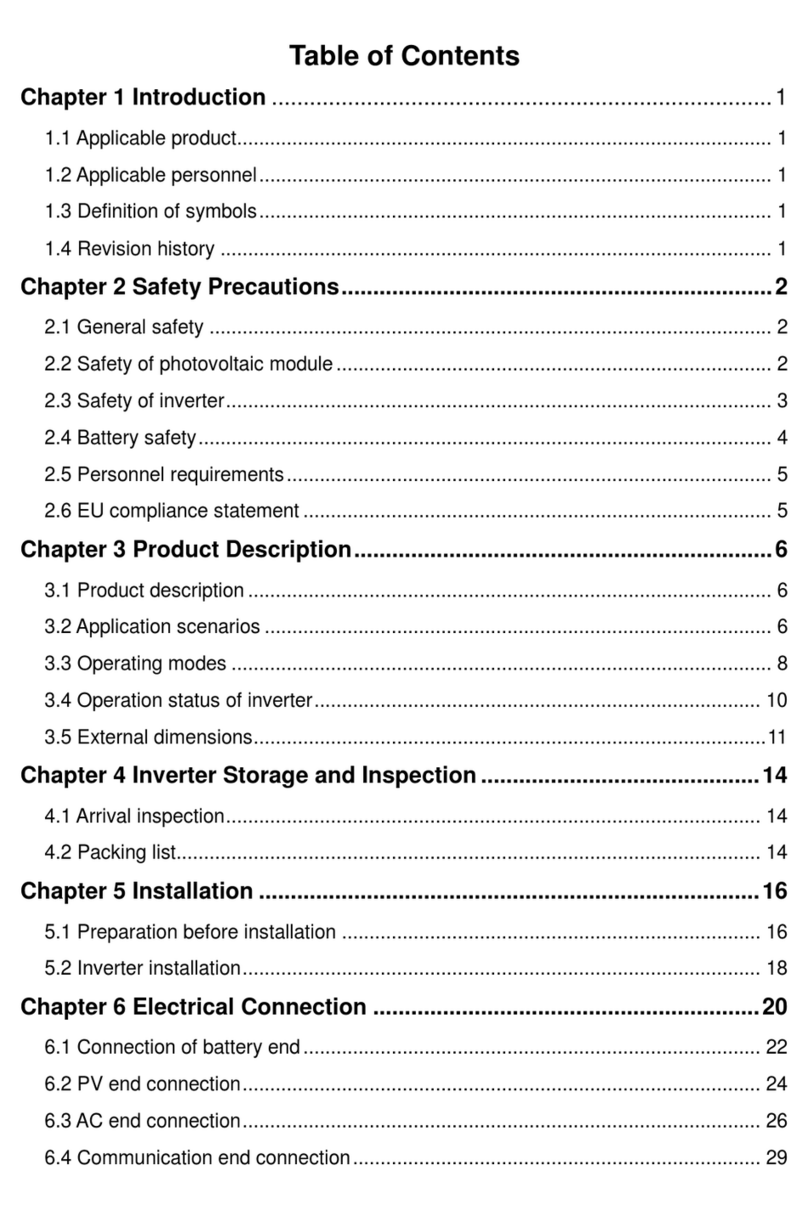
4
Betriebsumgebung
Stellen Sie den Wechselrichter auf eine feste, ebene und temperaturunempfindliche Oberfläche und stellen Sie keine schweren und/oder
brennbaren Gegenstände auf den Wechselrichter.
Achten Sie darauf, dass
•jederzeit eine ausreichende Belüftung gewährleistet ist. Stellen Sie den Wechselrichter so auf, dass keine Belüftungsschlitze verdeckt werden,
und lassen Sie mindestens 10 cm Abstand zu allen Seiten;
•keine direkten Wärmequellen (z.B. Heizungen) auf den Wechselrichter wirken;
•kein direktes Sonnenlicht oder starkes Kunstlicht auf den Wechselrichter trifft;
•der Kontakt mit Spritz- und Tropfwasser und aggressiven Flüssigkeiten vermieden und der Wechselrichter nicht in der Nähe von Wasser
betrieben wird. Insbesondere darf der Wechselrichter niemals untergetaucht werden. Stellen Sie keine mit Flüssigkeiten gefüllten Gegenstände
auf oder neben den Wechselrichter;
•Der Wechselrichter nicht in unmittelbarer Nähe von Magnetfeldern (z.B. Lautsprechern) steht;
•Keine offenen Brandquellen (z.B. brennende Kerzen) auf oder neben dem Gerät stehen;
•Keine Fremdkörper eindringen (z.B. Staub und sonstige kleinen Partikel);
•der Wechselrichter keinen starken Temperaturschwankungen ausgesetzt wird, da sonst Luftfeuchtigkeit kondensieren und zu elektrischen
Kurzschlüssen führen kann;
•die Umgebungstemperatur sich nicht außerhalb des Bereiches von 0 - 40°C befindet;
•die Luftfeuchte bei Lagerung < 55% und bei Betrieb < 85% ist;
•der Wechselrichter keinen übermäßigen Erschütterungen und Vibrationen ausgesetzt wird;
Kabel
Fassen Sie das Kabel mit Stecker immer am Stecker und ziehen Sie nicht am Kabel selbst. Fassen Sie die Anschlusskabel niemals mit nassen
Händen an, da dies einen Kurzschluss oder elektrischen Schlag verursachen kann. Stellen Sie weder den Wechselrichter noch schwere
Gegenstände auf die Kabel. Achten Sie darauf, dass die Kabel nicht geknickt werden, insbesondere nicht am Stecker bzw. an den Anschlussösen/-
klemmen. Machen Sie niemals einen Knoten in ein Kabel und binden Sie es nicht mit anderen Kabeln zusammen. Alle Kabel sollten so gelegt
werden, dass niemand darauf tritt oder behindert wird. Schützen Sie die Kabel vor scharfkantigen und spitzen Teilen. Nutzen Sie ggf. Leerrohre o.
Ä. Ein beschädigtes Anschlusskabel kann einen Brand oder elektrischen Schlag verursachen.
Prüfen Sie das Anschlusskabel von Zeit zu Zeit auf Beschädigungen und sonstige Veränderungen. Siehe auch Hinweise unter „Zubehör“.
Wartung und Pflege
Eine fachkundige Überprüfung ist erforderlich, wenn der Wechselrichter oder Zubehörteile von ihm beschädigt sind.Lassen Sie alle
Überprüfungsarbeiten nur von autorisiertem Fachpersonal durchführen. Reinigen Sie das Gerät nur mit einem sauberen und trockenen Tuch,
niemals mit aggressiven Flüssigkeiten. Versuchen Sie nicht, das Gehäuse der Wechselrichterzu öffnen. Dabei würde Ihr Gewährleistungsanspruch
verfallen.
Kinder
Elektrische Geräte gehören nicht in Kinderhände! Lassen Sie Kinder niemals unbeaufsichtigt elektrische Geräte benutzen. Kinder können mögliche
Gefahren nicht immer richtig erkennen. Kleinteile können bei Verschlucken lebensgefährlich sein. Halten Sie auch die Verpackungsfolien von
Kindern fern. Es besteht Erstickungsgefahr.
Bestimmungsgemäßer Gebrauch
Je nach Typ ist der Wechselrichter für den Anschluss an eine 12 oder 24 V Gleichspannungsquelle (z.B. KFZ-Batterie) zur Abgabe von
Wechselspannung mit 230 V ausschließlich zum Betrieb von Elektrogeräten bestimmt. Der Wechselrichter ist für dieprivate Anwendung konzipiert,
für kommerzielle Zwecke bedingt und für industrielle Einsätze nicht geeignet. Der Wechselrichter ist standardmäßig nicht für die Verwendung in
medizinischen, lebensrettenden oder lebenserhaltenden Anwendungen vorgesehen.
Er darf nicht in tropischen Klimaregionen verwendet werden. Es dürfen nur Anschlusskabel und externe Geräte verwenden werden, die
sicherheitstechnisch und hinsichtlich elektromagnetischer Verträglichkeit und Abschirmqualität dem vorliegenden Gerät entsprechen. Dieses Gerät
erfüllt alle im Zusammenhang mit der CE Konformität relevanten Normen und Standards. Bei einer nicht mit dem Hersteller abgestimmten
Änderung der Wechselrichter ist die Einhaltung dieser Normen nicht mehr gewährleistet.
Wichtige Hinweise zurVerwendung
•Beachten Sie bitte die Angaben für die Dauerausgangsleistung und die Spitzenleistung. Geräte mit einem höheren Anschlusswertals die
angegebene Dauerleistung dürfen an diesem Wechselrichter nicht betrieben werden. Die höhere Spitzenausgangsleistung dient nur der
Überbrückung kurzer Einschaltströme – für ca. 0,3 Sekunden.
•Achten Sie auf das akustische Warnsignal und die Kontrollleuchten. Wenn das Warnsignal ertönt bzw. die rote Kontrollleuchte leuchtet,
könnte die Kapazität der Spannungsquelle nahezu erschöpft sein und der Wechselrichter wird mit zu geringer Spannung versorgt. Schalten
Sie dann den angeschlossenen Verbraucher aus und trennen die Verbindung zur Spannungsquelle. Verwenden Sie den Wechselrichter erst
dann wieder, wenn die Spannungsquelle wieder aufgeladen wurde und den Wechselrichter mit ausreichend Spannung versorgen kann.
•Verwenden Sie nur die Kabel des mitgelieferten Zubehörs. Schließen Sie bei den Wechselrichtern mit 2 Anschlusspaaren (Geräte ab 1500 W)
auch immer die mitgelieferten 2 Kabelpaare an, da hier bei maximaler Leistung eingangsseitig sehr hohe Ströme fließen und der
Gesamtquerschnitt beider Kabelpaare erforderlich ist. Es besteht ansonsten Brandgefahr!































